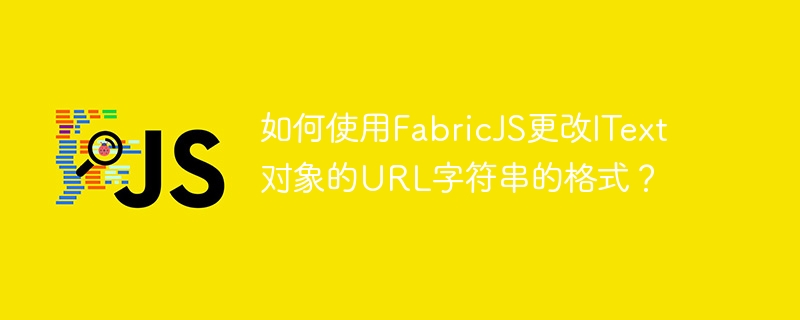所属分类:web前端开发

在本教程中,我们将学习如何使用 FabricJS 更改 IText 对象的 URL 字符串的格式。 IText 类是在 FabricJS 版本 1.4 中引入的,它扩展了 Fabric.Text 并用于创建 IText 实例。 IText 实例使我们可以自由选择、剪切、粘贴或添加新文本,而无需额外配置。还有各种支持的按键组合和鼠标/触摸组合使文本具有交互性,而 Text 中未提供这些组合。
然而,基于 IText 的 Textbox 允许我们调整文本矩形的大小并自动换行。对于 IText 来说情况并非如此,因为高度不会根据换行进行调整。我们可以通过使用各种属性来操作 IText 对象。同样,我们可以使用 format 属性来更改 IText 对象的 URL 字符串的格式。
toDataURL({ format: String }: Object): String
options(可选) - 此参数是一个对象,它为 IText 对象的 URL 表示形式提供额外的自定义。使用此参数可以更改高度、质量、乘数和许多其他属性,其中格式是属性
format - 该属性接受一个String值,它允许我们定义输出图像的格式。接受的值为“jpeg”或“png”。默认值为“png”。
不使用格式属性的默认值
让我们看一个代码示例,以查看使用 toDataURL 方法而不使用 format 属性时记录的输出。一旦我们从开发工具打开控制台,我们就可以看到 IText 对象的 URL 表示。我们可以复制该 URL 并将其粘贴到新选项卡的地址栏中以查看最终输出。由于我们没有指定图像的格式,因此它将根据设置的默认值“png”。
<!DOCTYPE html>
<html>
<head>
<!-- Adding the Fabric JS Library-->
<script src="https://cdnjs.cloudflare.com/ajax/libs/fabric.js/510/fabric.min.js"></script>
</head>
<body>
<h2>Default value without using the format property</h2>
<p> You can open console from dev tools and see that the URL representation of the IText object has a "png" format by default </p>
<canvas id="canvas"></canvas>
<script>
// Initiate a canvas instance
var canvas = new fabric.Canvas("canvas");
canvas.setWidth(document.body.scrollWidth);
canvas.setHeight(250);
// Initiate a shadow object
var shadow = new fabric.Shadow({
blur: 25,
color: "grey",
offsetX: 12,
offsetY: 15,
});
// Initiate an itext object
var itext = new fabric.IText(
"Add sample text here.Lorem ipsum dolor sit amet consectetur adipiscing.",{
width: 300,
left: 60,
top: 70,
fill: "#c70039",
backgroundColor: "#c1dfed",
stroke: "#c70039",
originX: "center",
shadow: shadow,
}
);
// Add it to the canvas
canvas.add(itext);
// Using the toDataURL method
console.log(itext.toDataURL());
</script>
</body>
</html>
使用 toDataURL 方法和 format 属性
让我们看一个代码示例,看看当 toDataURL 方法与 format 属性一起使用时,IText 对象是什么样子。在这种情况下,我们将能够指定最终图像的格式。由于此处分配的值为“jpeg”,因此最终图像将为“jpeg”格式。
<!DOCTYPE html>
<html>
<head>
<!-- Adding the Fabric JS Library-->
<script src="https://cdnjs.cloudflare.com/ajax/libs/fabric.js/510/fabric.min.js"></script>
</head>
<body>
<h2>Using the toDataURL method along with format property</h2>
<p> You can open console from dev tools and see that the URL representation of the IText object has a "jpeg" format now </p>
<canvas id="canvas"></canvas>
<script>
// Initiate a canvas instance
var canvas = new fabric.Canvas("canvas");
canvas.setWidth(document.body.scrollWidth);
canvas.setHeight(250);
// Initiate a shadow object
var shadow = new fabric.Shadow({
blur: 25,
color: "grey",
offsetX: 12,
offsetY: 15,
});
// Initiate an itext object
var itext = new fabric.IText(
"Add sample text here.Lorem ipsum dolor sit amet consectetur adipiscing.",{
width: 300,
left: 60,
top: 70,
fill: "#c70039",
backgroundColor: "#c1dfed",
stroke: "#c70039",
originX: "center",
shadow: shadow,
}
);
// Add it to the canvas
canvas.add(itext);
// Using the toDataURL method
console.log(itext.toDataURL({format: "jpeg"}));
</script>
</body>
</html>